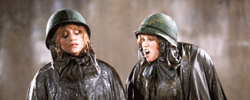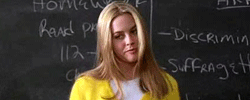Credits
Feature by: Matt Bailey, Adam Balz, Beth Gilligan, Leo Goldsmith, Chiranjit Goswami, Jenny Jediny, and Rumsey Taylor
Posted on: 25 July 2006
B. Ruby Rich once argued that a woman’s choice as film spectator could be narrowed down to two options: “to identify either with Marilyn Monroe or with the man behind me hitting the back of my seat with his knees.” Rich, one of the few major female film critics writing today, hit the nail on the head, particularly in regard to the specifically female-friendly film genre of the “chick flick.” In researching for this feature, it became abundantly clear that the term chick flick is applied to all films about, starring, and specifically marketed towards women. Wikipedia’s lengthy list of chick flicks runs a non-discriminating gamut that stretches back to the 1930s, lumping together film classics such as The Women with the recently released Failure To Launch. The term has a derogatory connotation – one that is certainly merited in some instances – but there is also a plethora of engaging films that are either overlooked or placed in this category without thorough analysis.
The term was first propagated in the 1993 film Sleepless in Seattle, when Sam’s sister makes an emotional attempt to convince him that the Deborah Kerr/Cary Grant weepie An Affair to Remember is the greatest movie ever made, only to have him dismiss it with the dreaded “chick flick” label. However, long before Meg Ryan and Tom Hanks planned their own rendezvous on top of the Empire State Building, Hollywood was producing movies specifically geared to the female demographic. In the 1930s, an era when their choices were severely limited, women could go to the local cinema to watch romantic or screwball comedies in which sharp-witted female stars such as Katharine Hepburn, Carole Lombard, Irene Dunne, Ginger Rogers, Claudette Colbert, and Barbara Stanwyck repeatedly reduced their male co-stars to hapless, bumbling creatures who (often literally) fell head over heels for them. On the other end of the spectrumstars like Bette Davis, Joan Crawford, Greer Garson, and Marlene Dietrich earned a following by playing independent, no-nonsense women whose steely sense of determination gave them the strength to endure even the toughest of circumstances.
During World War II, most of these stars spearheaded efforts to sell war bonds and headlined shows for the troops, in addition to appearing in movies such as Mrs. Miniver, So Proudly We Hail! and Since You Went Away–these actions demonstrated the important roles women could play both on the home front and on the battlefield. When the war ended, women not only found themselves back in their kitchens, but also onscreen in the lush, overblown melodramas of Douglas Sirk. Although dismissed at the time, Sirk’s films later found great acclaim with the members of the Cahiers du Cinéma, who not only raised Sirk to an iconic status as director, but found that beneath the baubles and saturated surface lay deep commentary on dividing issues in the United States at the time of their release, ranging from racism to economic greed.
During the same time period, new actresses were on the rise in Hollywood, and the term ”bombshell” gained notoriety as audiences flocked to see films starring Brigitte Bardot, Jayne Mansfield, Jane Russell, Sophia Loren, Elizabeth Taylor, and Marilyn Monroe. While these women made films that brought sex blatantly onscreen, a backlash occurred in the early 1960s as older audiences longed for something far more innocent. That naiveté was found in the films of Rock Hudson and Doris Day, whose virgo intacta sex comedies kept Day the eternal virgin pursued by Hudson whose widely known homosexuality gave the films an even more ridiculous air. Years later, however, Day was embraced by film scholars such as Molly Haskell, who noted that the star almost uniformly played successful career women who dictated romance on their own terms. This is a marked contrast from the late 1960s and 1970s, when female stars all but disappeared from the silver screen. While Jane Fonda, Diane Keaton, Faye Dunaway, and Barbra Streisand managed to keep their heads above water, the decade was dominated by car chases, the Mafia, bank robberies, battlefields, mental hospitals, and camping trips, all of which left women on the sidelines. This imbalance was not fully redressed until the late 1980s, with the success of such films as When Harry Met Sally…, Moonstruck, and Working Girl, and shortly thereafter, Pretty Woman and Ghost. Not so coincidentally, this is when the term “chick flick” made its way into the cultural lexicon.
Although the aforementioned films empower, star or were at least targeted toward women, the present day chick flick seems to fall into place as a separate genre, a sort of illegitimate offspring of its forbearers. Certainly women today may enjoy Gentleman Prefer Blondes and Mildred Pierce, but while there is a serious amount of critical discourse on these established classics, more contemporary chick flicks remain largely ignored. This is not an uncommon trend with the “women’s picture”; an inordinate number of films now lauded within cinematic study and criticism, particularly those within feminist and queer studies, only found recognition through such revisionist study and new generations of filmgoers. Within popular film criticism, the chick flick has yet to gain recognition beyond the glib and dismissive jargon reviewers of both sexes typically attach to this much-maligned subcategory.
Although the selections in this feature are eclectic, it is apparent that some of these films may never receive any sort of cinematic canonization. Chick flicks are undoubtedly a phenomenon – one that Hollywood has banally carved into a marketable niche with occasional bursts of intelligence and originality coming out from under the radar – but perhaps it is the overshadowing of these lesser-known gems that encourages critical reevaluation. This feature includes several of them, each with a substance beneath an often romantic, sentimental surface.
Introduction by Beth Gilligan and Jenny Jediny
Films
Features
| Meditations on the Little Black Dress | 1961 |
| When Meg Met Nora… | 1991–1998 |
Reviews
| Private Benjamin | 03 July |
| Working Girl | 04 July |
| Say Anything | 03 July |
| Pretty Woman | 03 July |
| Ghost | 25 July |
| Truly Madly Deeply | 25 July |
| Fried Green Tomatoes | 03 July |
| Gas Food Lodging | 03 July |
| The Last of the Mohicans | 20 July |
| The Bridges of Madison County | 03 July |
| Clueless | 03 July |
| The Truth About Cats & Dogs | 03 July |
| Walking and Talking | 03 July |
| Erin Brockovich | 03 July |
| Bring It On | 24 July |
| Bridget Jones’s Diary | 04 July |
| Bend It Like Beckham | 10 July |
| Mean Girls | 03 July |
By Matt Bailey, Adam Balz, Beth Gilligan, Leo Goldsmith, Chiranjit Goswami, Jenny Jediny, and Rumsey Taylor ©2006 NotComing.com
Reviews
-

The Truth About Cats & Dogs
1996 -

Say Anything
1989 -

Gas Food Lodging
1992 -

Pretty Woman
1990 -

Walking and Talking
1996 -

Mean Girls
2004 -

Fried Green Tomatoes
1991 -

Private Benjamin
1980 -

Clueless
1995 -

Erin Brockovich
2000 -

The Bridges of Madison County
1995 -

Bridget Jones’s Diary
2001 -

Working Girl
1988 -

Bend It Like Beckham
2002 -

Bring It On
2000 -

Ghost
1990 -

Truly Madly Deeply
1991 -

The Last of the Mohicans
1992
We don’t do comments anymore, but you may contact us here or find us on Twitter or Facebook.



